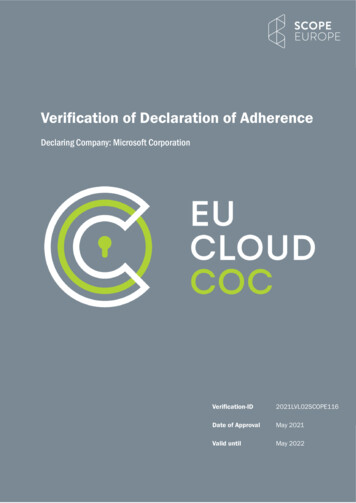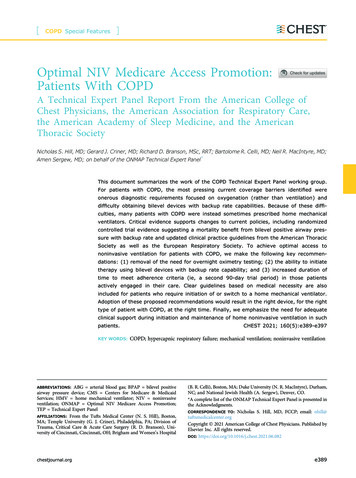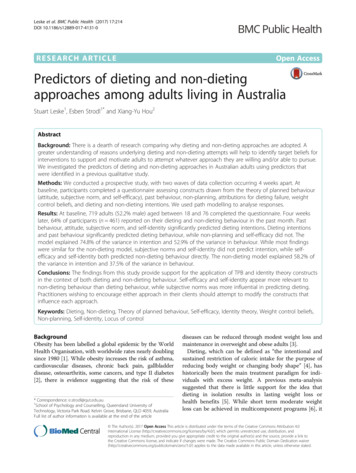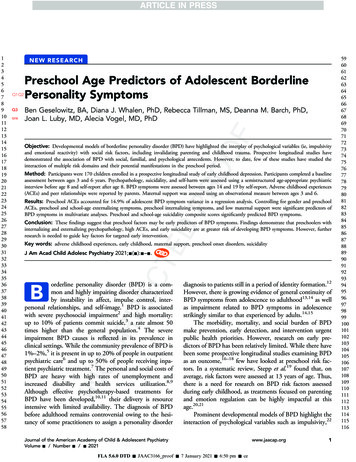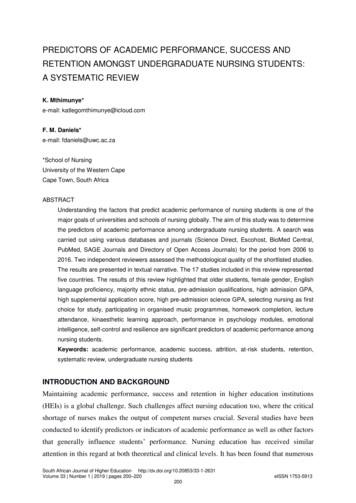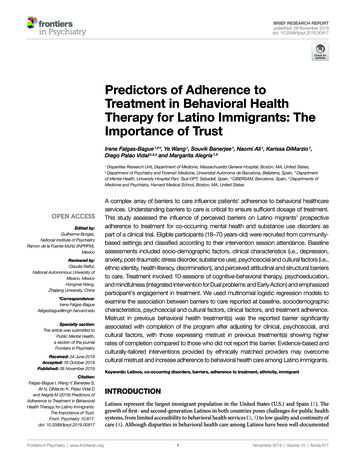
Transcription
Brief Research Reportpublished: 08 November 2019doi: 10.3389/fpsyt.2019.00817Predictors of Adherence toTreatment in Behavioral HealthTherapy for Latino Immigrants: TheImportance of TrustIrene Falgas-Bague 1,2*, Ye Wang 1, Souvik Banerjee 1, Naomi Ali 1, Karissa DiMarzio 1,Diego Palao Vidal 2,3,4 and Margarita Alegría 1,5Disparities Research Unit, Department of Medicine, Massachusetts General Hospital, Boston, MA, United States,Department of Psychiatry and Forensic Medicine, Universitat Autònoma de Barcelona, Bellaterra, Spain, 3 Departmentof Mental Health, University Hospital Parc Tauli-I3PT, Sabadell, Spain, 4 CIBERSAM, Barcelona, Spain, 5 Departments ofMedicine and Psychiatry, Harvard Medical School, Boston, MA, United States12Edited by:Guilherme Borges,National Institute of PsychiatryRamon de la Fuente Muñiz (INPRFM),MexicoReviewed by:Claudia Rafful,National Autonomous University ofMexico, MexicoHongmei Wang,Zhejiang University, China*Correspondence:Irene Falgas-Bagueifalgasbague@mgh.harvard.eduSpecialty section:This article was submitted toPublic Mental Health,a section of the journalFrontiers in PsychiatryReceived: 24 June 2019Accepted: 16 October 2019Published: 08 November 2019Citation:Falgas-Bague I, Wang Y, Banerjee S,Ali N, DiMarzio K, Palao Vidal Dand Alegría M (2019) Predictors ofAdherence to Treatment in BehavioralHealth Therapy for Latino Immigrants:The Importance of Trust.Front. Psychiatry 10:817.doi: 10.3389/fpsyt.2019.00817Frontiers in Psychiatry www.frontiersin.orgA complex array of barriers to care influence patients' adherence to behavioral healthcareservices. Understanding barriers to care is critical to ensure sufficient dosage of treatment.This study assessed the influence of perceived barriers on Latino migrants' prospectiveadherence to treatment for co-occurring mental health and substance use disorders aspart of a clinical trial. Eligible participants (18–70 years-old) were recruited from communitybased settings and classified according to their intervention session attendance. Baselineassessments included socio-demographic factors, clinical characteristics (i.e., depression,anxiety, post-traumatic stress disorder, substance use), psychosocial and cultural factors (i.e.,ethnic identity, health literacy, discrimination), and perceived attitudinal and structural barriersto care. Treatment involved 10-sessions of cognitive-behavioral therapy, psychoeducation,and mindfulness (Integrated Intervention for Dual problems and Early Action) and emphasizedparticipant's engagement in treatment. We used multinomial logistic regression models toexamine the association between barriers to care reported at baseline, sociodemographiccharacteristics, psychosocial and cultural factors, clinical factors, and treatment adherence.Mistrust in previous behavioral health treatment(s) was the reported barrier significantlyassociated with completion of the program after adjusting for clinical, psychosocial, andcultural factors, with those expressing mistrust in previous treatment(s) showing higherrates of completion compared to those who did not report this barrier. Evidence-based andculturally-tailored interventions provided by ethnically matched providers may overcomecultural mistrust and increase adherence to behavioral health care among Latino immigrants.Keywords: Latinos, co-occurring disorders, barriers, adherence to treatment, ethnicity, immigrantINTRODUCTIONLatinos represent the largest immigrant population in the United States (U.S.) and Spain (1). Thegrowth of first- and second-generation Latinos in both countries poses challenges for public healthsystems, from limited accessibility to behavioral health services (2, 3) to low quality and continuity ofcare (4). Although disparities in behavioral health care among Latinos have been well-documented1November 2019 Volume 10 Article 817
Falgas-Bague et al.Predictors of Treatment Adherence for Latino Immigrantsin the U.S. (5), there is a paucity of research in both countriesidentifying factors that might shape adherence to behavioralhealth treatments among Latino populations. A complex array ofpsychological, cultural and sociodemographic factors influencesan individual's entry and adherence to behavioral health care(6). Thus, identifying salient barriers to care is a critical task forclinicians and administrators.Existing literature suggests that individuals with co-occurringmental health and substance use disorders (COD) accessbehavioral health treatment at extremely low rates compared toindividuals without co-morbidities (7). For example, only 9.1%of these individuals receive treatment for both disorders, while52.5% receive no treatment at all (8). Yet, integrated treatments areamong the most effective interventions for persons with COD (9,10). Nevertheless, Latinos face unique barriers inhibiting accessto specialized treatment (11). Research has shown that Latinoshave lower rates of treatment adherence, attending fewer sessionsand prematurely dropping out of cognitive behavioral therapy(CBT) compared to non-Latino Whites (12). These differenceshave been attributed to the double stigma associated with mentalillness and being an ethnic minority, logistical, motivational, andattitudinal factors (13–15). For example, a previous study foundthat approximately 50% of Latino immigrants reported selfreliant attitudes regarding behavioral health care (e.g., wantingto handle problems on one's own) and structural barriers (e.g.,difficulties with transportation and scheduling flexibility). Thestudy identified these barriers as significant obstacles to treatmentadherence (16). Even if Latino immigrants view their symptomsas warranting attention, they are unlikely to seek treatment ifthey do not believe they will benefit from professional services.According to Andersen-Newman's healthcare utilizationmodel (17), predisposing (e.g., sociodemographic characteristicsand attitudes toward health care), enabling (e.g. employment),and clinical factors (e.g. symptoms and severity) determine anindividual's ability to cope and command resources to deal withproblems, shaping his/her use of services (18). An extension ofthis model includes psychosocial factors such as discriminationand health literacy to better comprehend the complex role ofrace/ethnicity in help-seeking (19, 20). Yet, the literature isinconclusive with regards to how these factors predict adherenceto treatment.One strategy that has been effective in improving adherenceamong Latino populations is culturally adapting interventions(21). To this end, we conducted a multisite randomized trial ofthe "Integrated Intervention for Dual Problems and Early Action"(22), which was specifically designed to treat immigrant and U.S./Spain-born Latinos with COD (NIDA Grant R01DA034952).The trial was implemented at three sites (Boston, Madrid, andBarcelona) and incorporated a patient-centered, communitybased approach. Treatment took place in-person or by phone andincluded extended outreach on Saturdays and Sundays.The current study aimed to assess predictors of treatmentadherence in a large sample of Latino immigrants with COD.There are several aspects that make our study novel. First, weassess several barriers before immigrants enter treatment todetermine if they predict individuals' adherence to care. Second,we include immigrants from two countries, which allows usFrontiers in Psychiatry www.frontiersin.orgto better assess characteristics that encourage adherence inimmigrant populations. Third, we include a wide array of factorsto determine if barriers remain important factors after adjustingfor sociodemographic, clinical, and psychosocial characteristicsin a heterogeneous sample of Latino immigrants. To do this, weevaluated predictors of adherence to treatment based on thethree groups that best represented the distribution of patientparticipation into the Integrated Intervention for Dual problemsand Early Action (IIDEA) intervention: 0–1 sessions (tercile 1 orreference category), 2–9 sessions (tercile 2), and 10–12 sessions(tercile 3) (see Figure 1s in Supplementary Material).METHODSStudy Design and SettingData were drawn from baseline interviews and clinical trial datacollected for the International Latino Research Partnership, amultisite study that sought to improve behavioral health careservices for Latino migrants (22). Participants were enrolledbetween September 2014 and February 2017 through directcontact in clinic waiting rooms, emergency departments,community-based organizations, or through healthcareprofessionals and participant referrals. Participating clinics wereaffiliated with large safety-net health care systems serving diversepopulations. All participants provided informed consent beforeparticipating in the trial. The study was approved by the reviewboards of all participating institutions.ParticipantsEligible participants were those between 18–70 years old whoself-identified as Latino (from any Spanish-speaking country—Caribbean, Central America and Mexico, or South America),and who had migrated to the U.S. or Spain. Participants had toscreen positive for comorbid mental health and substance misuse(COD) but report not currently receiving specialty behavioralhealth services (i.e., therapy with a psychiatrist, psychologist, orsocial worker) in the past 3 months or upcoming month. PositiveCOD screening included an affirmative response to two questionsabout mental health and two about substance use on the AC-OKscreener (23), a 15-item questionnaire validated in Spanish (24).Sensitivity and specificity of the questionnaire was shown to beconsistent with standardized screeners (24). Internal consistencywas comparable to the original English sample (α 0.82 formental health and α 0.90 for substance abuse). Participantswere excluded only if they lacked capacity to consent, assessed bya validated screener (25), or reported suicidal ideation, assessedwith the Paykel Suicide Scale (26).ProceduresFor the study, 2,284 prospective participants were approacheddirectly by the research team in clinic waiting rooms or werereferred by primary care providers or staff from communityagencies and then contacted by phone. Of these, 384 wereeligible to participate and 341 agreed to a baseline interview.Trained interviewers conducted research assessments in Spanish2November 2019 Volume 10 Article 817
Falgas-Bague et al.Predictors of Treatment Adherence for Latino Immigrantsor English depending on participants' preferred language.Interviews were audio-recorded and lasted approximately 1hour. Participants were compensated with 40/ 30 gift cards forthe assessment, but not for participating in treatment sessions.Upon completion of the baseline assessment, participants wererandomized to the IIDEA intervention or enhanced usual careas part of the control group. Participants in the control groupwere contacted four times throughout the intervention period bya care manager, who administered the brief assessment used inclinical sessions and monitored each patient's mental health toassess increases in symptoms that might require specialized care.A member of the research team contacted those randomized tothe intervention group (n 172) to schedule the first appointmentwith a clinician. Clinicians were also randomized per patients'available times for treatment.race/ethnicity (White, Black, Indigenous/Native American,Hispanic/Latino/Caribbean, and Mixed Race), highest educationlevel obtained, socioeconomic status (classified into twocategories; total personal annual income 15,000 or 15,000),immigration status (defined by citizen or non-citizen to hostcountry) and employment status (1 if employed, including parttime; 0, otherwise).Psychosocial and Cultural FactorsWe assessed individuals' perceived discrimination, interculturalfamily conflict, health literacy, time in the host country, andnumber of visits to their country of origin as psychosocial andcultural factors that could predict adherence to the intervention.Participants completed the Everyday Discrimination Scale (EDS;range 9 to 54) (27, 28), previously used in the National Latinoand Asian American Study (α 0.82) (29). The EDS assessed howoften participants experienced unfair treatment in their day-today life. Response categories ranged from 1 (never) to 6 (almostevery day), with higher scores indicating greater perceiveddiscrimination. To assess intercultural family conflict, we usedfour items of the Family/Culture Stress subscale of the HispanicStress Inventory (range 0 to 10) (α 0.67) (30), designed tomeasure family interference with personal goals, arguments withfamily members, and the breakdown of the family unit. Senseof belonging was also assessed using one item (coded as yes 1, otherwise 0) from the Family/Culture Stress subscale (30).The 3-item Ethnic Identity Scale (α 0.73), derived from the35-item Cultural Identity Scale for Latino Adolescents (range 3–12) (31), was used to gauge cultural identity, with questionspertaining to participants' self-identified culture or racial/ethnicgroup. We also collected data on the amount of time participantshad spent in their host country (US or Spain) and number ofvisits to their country of origin in the past 12 months. We assessedhealth literacy with three questions from the Health LiteracyScreening Questionnaire (range 3–15) (32), which assessedparticipant's ability to perform basic tasks and understand healthcare information ("How confident are you filling out medicalforms on your own?"). Another item from the Single ItemLiteracy Screener (33) was added to the health literacy scale toidentify patients from diverse populations with limited readingability (α 0.80).InterventionIIDEA was designed to maintain fidelity to evidence-basedapproaches while addressing a range of mental healthconditions (e.g., depression, anxiety, traumatic stress, mild tomoderate drug/alcohol abuse) in Latino adults. IIDEA is a brief,transdiagnostic therapy model adapted to engage and retainLatino participants in treatment. The program involves 10 weeklysessions delivered over 3–4 months by trained clinicians whoattend weekly supervision meetings. Depending on participant'sneeds, two extra sessions were offered at the end of the program.IIDEA integrates elements of CBT, motivational interviewing,relapse prevention, assertive communication, and HIV/STDrisk prevention. The program also includes basic elements of thecultural formulation model to improve participant engagementin treatment. Clinicians included psychiatric residents, clinicalpsychologists, and social workers. All clinicians were fluentSpanish speakers, with five of the 14 total clinicians self-identifyingas Latinos; the remaining nine clinicians were Spanish natives.Depending on the participant's preferences, the interventionwas delivered in-person at a clinic or community setting or overthe phone. The goals of the program were to: engage, elicit, andimprove coping skills to reduce symptoms of depression, anxiety,and PTSD; improve assertive communication skills; reduce oreliminate alcohol and substance use problems; and reduce HIV/STD risk behaviors.Perceived Barriers to CareMeasurementsWe asked participants about 11 barriers to behavioral healthtreatment at baseline (coded as 0 if not mentioned, and 1 if yesfor each barrier) according to their previous experiences. If theparticipant reported not having any previous experience withaccessing behavioral health services, the research assistant askedher/him to think about what barriers she/he thinks they wouldhave encountered. The list of reported barriers was a combinationof attitudinal and structural factors that may influence healthcare utilization according to the model. Attitudinal barriers(related to the individual's beliefs and values) included "wantingto handle a problem on one's own," "thinking treatment wouldnot work," "concerns about stigmatization," and "concerns aboutpoor treatment because of one's ethnic/racial background."Structural barriers (related to individual's perception ofAdherence to IIDEA InterventionWe measured adherence by the number of sessions attended.We first explored the distribution of participants according toattendance to inform how to group the participants (see Figure 1sin Supplementary Material). The first group (tercile 1) comprisedparticipants who either never started the intervention or attendedonly one session. The second group (tercile 2) included those whohad completed two to nine sessions, and the third group (tercile 3)included those who completed 10 or more sessions.Sociodemographic and Predisposing FactorsDemographic factors included age, gender, and site of recruitment(Barcelona, Madrid, or Boston). We also collected self-reportedFrontiers in Psychiatry www.frontiersin.org3November 2019 Volume 10 Article 817
Falgas-Bague et al.Predictors of Treatment Adherence for Latino Immigrantsthe health care system) included "fear of not knowing howto communicate problems because of language barriers,""previous negative experiences with treatment," "treatmentcost," and "problems with transportation and scheduling times."Participants indicated whether they had experienced each barrierand had the opportunity to add additional barriers not describedin the assessment.care and treatment adherence while controlling for demographic(age, gender, site, employment status), psychosocial(discrimination), and clinical (HSCL, benzodiazepine use scale,ASI alcohol scores at baseline) factors. To mitigate the issue ofmulti-collinearity among the baseline characteristics, our finalmodel included those with significant subgroup differences atthe 95% confidence level—site, benzodiazepine dependence, ASIalcohol, HSCL, and two measures of treatment barriers—as wellas basic demographics (age, gender), employment status, and ameasure of everyday discrimination, as we hypothesized thatthese would be significant predictors of immigrants' adherenceto care (50). To address missing data in the HSCL instrument(19% of observations were missing because the instrument wasadministrated later in the study), we implemented multipleimputation methods using the "mi" procedure in Stata (51).This technique creates twenty complete datasets, imputesmissing values using a chained equations approach, analyseseach dataset, and uses standard rules (52) to combine estimatesand adjust standard errors for uncertainty due to imputation.We also conducted a sensitivity analysis excluding the HSCLinstrument from the multinomial regression. For missing valuesother than HSCL measure, we used list-wise deletion for (N 3; 1.7%); so, the analytic sample for the multivariate analysiscomprised 169 observations.Illness Level/Clinical FactorsDepression was measured with the Patient Health Questionnaire(PHQ-9) (α 0.85) (34, 35), as assessed by DSM-IV diagnosticcriteria of major depressive disorder. We also administered thebrief General Anxiety Disorder scale (GAD-7) (α 0.86) (36, 37),a seven-item clinical screener for generalized anxiety. To assesstrauma, we included the Brief Trauma Questionnaire (BTQ)(38), a 10-item self-reported measure that examines experiencesof potentially traumatic events, and the Post-Traumatic StressDisorder Checklist (PCL-5) (α 0.94) (39, 40), a self-reportedmeasure of the DSM-V symptoms of PTSD. We also used theHopkins Symptoms Checklist (HSCL-20) (α 0.92) (41), a20-item measure assessing symptoms of anxiety and depression.The resulting score is the average rating across all items (range:0–4) with higher scores indicating more severe symptoms.Substance use was measured using: the Alcohol Use DisordersIdentification Test (AUDIT) (α 0.78) (42, 43), a World HealthOrganization screener for excessive drinking; the Drug AbuseScreening Test (DAST) (α 0.87) (44, 45), a 10-item, yes/no selfreported instrument designed to screen for substance use; drug(α 0.84, range: 0–1, cut-off: 0.1 ) and alcohol sections (α 0.70,range: 0–1, cut-off: 0.1 ) of the Addiction Severity Index (ASI)Lite (46) which evaluates lifetime and past 30-day behaviors; anda selection of eight items from the Benzodiazepine DependenceQuestionnaire (BDEPQ) (α 0.90) (47) that measure dependenceto benzodiazepine tranquilizers, sedatives, and hypnotics. Wemeasured smoking using the Fagerström Test for NicotineDependence (48, 49) (α 0.75), a standard six-item instrumentassessing the intensity of physical addiction to nicotine.RESULTSAdherence to InterventionTable 1 summarizes the baseline sociodemographic characteristicsof the sample and the three categories of treatment adherence.Across the three sites, 27.9% (N 48) of participants attended0–1 sessions, 34.9% attended (N 60) 2–9 sessions, and 37.2%(N 64) of participants completed the whole program, attending10 or more sessions. Adherence across the recruitment sites wassignificantly different (p 0.012), with Barcelona exhibiting thelowest rates. No significant differences in treatment adherencewere found by age, gender, race/ethnicity, region of origin,socioeconomic status, employment, or education.Participants randomized to receive the IIDEA interventiondiffered in terms of sociodemographic and clinical characteristicsbetween the participants across the three sites (Boston, Madrid,and Barcelona) as well as between the participants in Spain(Madrid Barcelona) and the US (Boston). Table 1s in theSupplementary Material reflects these differences. Overall,participants recruited in Spain were younger, with highereducation level, mostly coming from South America (89.1%),being first generation immigrants without citizenship and lowersense of belonging while participants recruited in U.S. were olderand reported being of Caribbean or Central American origin(including Mexico) in a much higher proportion (40.9% and36.4%, respectively). Participants in the U.S. reported longertime from migration compared to those recruited in Spainand reported higher scores in the measures of discrimination,acculturation stress, depression, anxiety, trauma, and smokingbut lower scores in the alcohol abuse (AUDIT) measure.Statistical AnalysisOur sample includes only participants from the interventionarm of the study (N 172), divided into subgroups accordingto the number of treatment sessions they received: 0–1 sessions(tercile 1) (N 48), 2–9 sessions (tercile 2) (N 60), and 10–12sessions (tercile 3) (N 64). We assessed differences betweenthe three subgroups, comparing proportions and means (withstandard deviations) of sociodemographic, clinical measures,and sociocultural factors, by using bivariate regression andPearson Chi-square tests for inter-group differences forcontinuous and categorical baseline characteristics. We alsosummarized individual barriers to care reported by participantsand assessed subgroup differences using Chi-square tests withpairwise comparison of 2–9 treatment sessions (tercile 2) and10–12 treatment sessions (tercile 3) versus those who attended0–1 session (tercile 1 as reference category). Using multinomiallogit models, we evaluated the associations between barriers toFrontiers in Psychiatry www.frontiersin.org4November 2019 Volume 10 Article 817
Falgas-Bague et al.Predictors of Treatment Adherence for Latino ImmigrantsTABLE 1 Sociodemographic individual characteristics and adherence to intervention (N 172).Total intervention sample (n 172)SiteBostonMadridBarcelonaAge category18–3435–4950 GenderMaleFemaleRace†WhiteBlackIndigenous/Native AmericanHispanic/Latino/CaribbeanMixedRegion of originUnited States/SpainCentral America and MexicoSouth AmericaCaribbeanEducation levelLess than high school HS diploma, GED, vocational school,or moreTotal personal income before tax inpast year†† US 15,000 US 15,000Employment statusUnemployedEmployedTreatmentadherencetercile 1(0–1 sessions)(n 48)Treatmentadherencetercile 2(2–9 sessions)(n 60)Treatmentadherencetercile 3(10–12 sessions)(n .748.342.257.80.568Column percentage summed across racial groups exceeds 100% due to rounding up to first decimal point.Reported total personal income before tax is not adjusted for cost of living in the two countries.†††Reported Barriers and Adherence to theIIDEA InterventionTable 2 presents bivariate relationships between psychosocial,cultural and clinical factors, reported barriers to care, and treatmentadherence. Adherence to the intervention was not related topsychosocial or cultural factors. Those who reported at least onebarrier (89.0% of the sample) had significantly higher treatmentadherence compared to those who reported no barriers (p 0.007).Moreover, those who reported three or more barriers (59.3% of thesample) showed higher treatment adherence compared to those whoreported zero, one, or two barriers (p 0.004). Bivariate analysesof baseline clinical profile with treatment adherence groups (Table2) showed that participants with higher scores on the HSCL-25exhibited higher adherence to the program than those with lowerscores (p 0.027). The same pattern was observed for participantswith higher scores on the BDEPQ (p 0.009) and ASI Alcohol (p 0.042). No significant associations were found regarding the otherclinical factors (e.g., PHQ-9, PCL-5, Fagerström Test).Frontiers in Psychiatry www.frontiersin.orgThe association of perceived barriers to care and adherence totreatment is depicted in Table 3. Reported barriers of mistrustin previous treatment(s) (p 0.007) and transportationor scheduling problems (p 0.003) were both significantpredictors of greater treatment adherence (10 sessions vs.0–1 sessions).Results of the association between barriers to care andtreatment adherence after adjusting for psychosocial,demographic, and clinical factors are presented in Table 4.Participants who reported mistrust in previous treatment(s)had significantly higher odds of completing 10–12 treatmentsessions (tercile 3) vs. 0–1 sessions (tercile 1) (OR 3.79,CI [1.49,9.66]). Transportation or scheduling problems,benzodiazepine dependence, discrimination, HSCL-25, and5November 2019 Volume 10 Article 817
Falgas-Bague et al.Predictors of Treatment Adherence for Latino ImmigrantsTABLE 2 Baseline barriers, social, cultural, and clinical factors and adherence to IIDEA (N 172).Generations1st Generation2nd GenerationCitizenship†NoncitizenCitizenSense of belonging†NoYesSpeak language in the host Country†NoYesHealth Literacy ScaleMedianInterquartile rangeDiscrimination ScaleMedianInterquartile rangeEthnic Identity ScaleMedianInterquartile rangeFamily Conflict ScaleMedianInterquartile rangeAcculturative Stress ScaleMedianInterquartile rangeYears in US/SpainReported barriersNumber of reported barriers 3 3 barriers reportedAny reported barriersNoYesClinical factorsDepression (PHQ-9)Generalized anxiety (GAD-7)PTSD (PCL)Drug abuse (DAST)Alcohol abuse (AUDIT)Benzodiazepines (BDEPQ)ASI AlcoholASI DrugHopkins Symptom Checklist (HSCL)‡Smoking (Fagerström)Reported trauma exposureNoYesTotal IIDEASample(n 172)IIDEAadherencetercile 1(0–1 sessions)(n 48)IIDEAadherencetercile 2(2–9 sessions)(n 60)IIDEAadherencetercile 3(10–12 sessions)(n 1490.0930.776Column percentage sum exceeds 100% due to rounding up to first decimal point.The Hopkins Symptom Checklist was missing for 32 cases since the instrument was administrated later in the study.†‡ASI Alcohol measures were not significantly related to treatmentadherence in the multinomial logistic models after adjustingfor other factors. A sensitivity analysis excluding the imputedHSCL-25 instrument yielded no substantial differences inthe associations between the measures of barriers to care andtreatment adherence.Frontiers in Psychiatry www.frontiersin.orgDISCUSSIONTo our knowledge, this is one of the few studies to prospectivelyexamine perceived barriers to care associated with adherenceto culturally-adapted cognitive behavioral interventions aimedat treating co-occurring mental health and substance use6November 2019 Volume 10 Article 817
Falgas-Bague et al.Predictors of Treatment Adherence for Latino ImmigrantsTABLE 3 Reported barriers to care and adherence to treatment (N 172).Reported barrier to care:Want to handle the problemon your ownNoYesThink the previous treatmentwould not workNoYesReceived treatment beforeand it didn't workNoYesConcerned about how muchmoney it would costNoYesConcerned about what peoplewould think if they found outyou were in treatmentNoYesHave problems with things liketransportation or schedulingthat made it hard to get totreatme
adherence to treatment for co-occurring mental health and substance use disorders as part of a clinical trial. Eligible participants (18-70 years-old) were recruited from community- . associated with completion of the program after adjusting for clinical, psychosocial, and . moderate drug/alcohol abuse) in Latino adults. IIDEA is a brief,



